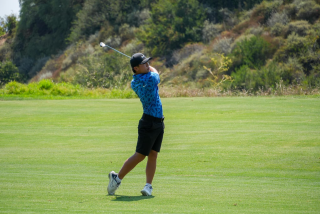LPGA Program Opens Fairways for Disadvantaged Youths
- Share via
Growing up in the Ramona Gardens housing projects, a low-income area of East Los Angeles, Jose Navarro found salvation in an unlikely place: the golf course.
As a 12-year-old in 1989, Navarro, now a freshman at California, participated in the inaugural season of the LPGA Junior Golf Program, designed to introduce the sport to underprivileged youth. The program changed his life.
On Monday, the LPGA’s youth program will conduct a pro-am tournament at Woodland Hills Country Club in an attempt to raise funds so that it may continue to supply equipment and free golf instruction for needy children who volunteer for the program.
Hosting the tournament is LPGA touring professional Kay Cockerill. Included in the field of 150 golfers will be Meg Mallon, who won the 1991 women’s U.S. Open and is currently fifth on the LPGA tour money list, and Helen Alfredsson, the 1993 Dinah Shore Classic champion who is 26th on the list.
Other top-30 money winners for 1996 in the field are Kristal Parker-Gregory (10th) and Barb Mucha (30th). Sandra Palmer, who has 21 tour victories, also will play.
John Morrison, the LPGA Junior Golf Program director, said he expects to raise $50,000 with the tournament, which carries a minimum entry fee of $750. Most of the money will go toward greens fees for the expected 600 Southern California participants in the program that opens its season April 17.
“Access is the most-critical factor here,” Morrison said. “As long as the kids can get on the course and can afford it then we’re keeping them off the streets and we’re giving them an alternative to gangs and violence.”
Navarro, who will speak at a banquet following the tournament, took advantage of such an alternative.
Like many other youths in his neighborhood, Navarro sought a way to stretch his horizons beyond the boundaries of the housing project. When he saw a sign at the local recreation center advertising free golf instruction, he jumped at the chance.
“[The golf program] was a whole different kind of opportunity to get out of the neighborhood,” said Navarro, now 18. “It was almost a refuge. I could get out of the city, rest and enjoy the peace of the golf course.”
The LPGA and the Amateur Athletic Foundation (AAF) started the program in 1989 in Los Angeles. The program has since expanded to Portland, Detroit and Wilmington, Del.
The LPGA’s Teaching and Club Professionals Division, which does the instruction, established a curriculum that the young golfers must follow to complete the course.
Each student begins with a 10-week series that provides basic instruction and introduces golf to kids, some of whom had never picked up a club. A six-week junior level follows, emphasizing further instruction and explanation of lesser-known rules and etiquette.
After they complete the junior level, students, who still receive free lessons, are allowed to golf without adult supervision.
“That’s kind of a big step getting there,” Morrison said. “We cut them loose and we have complete confidence that they know how to take care of themselves and the golf course.”
*
For the program’s better golfers, a mini-tour has been established, but Morrison says that the program is not necessarily designed to turn out professional-level golfers.
“The benefits of the program are access and equipment,” he said. “The first priority is to give the kids avenues so that they can continue to learn and play the game. It’s really a neat cycle to watch.”
Morrison added that learning the game of golf is not the only benefit of the program.
“We use golf as the vehicle,” he said. “But it teaches so many other things in terms of values, self-esteem, respect for yourself and your environment.”
Navarro, who shoots in the 70s and is considering cracking the Cal team as a walk-on, is proof of the program’s benefits.
Before joining the program, he said, college was so remote from his world view he couldn’t tell the difference between a junior college and a university.
But that changed while he spent time on the course.
“If somebody mentioned Cal, I thought they were talking about Cal State L.A.,” he said. “College was never in my plans, never part of my vision. The [golf] instructors introduced college to me.”
But college isn’t all Navarro learned about on the golf course.
“It helps you academically and socially,” he said. “In East L.A. everyone is Latino, but on the course there are Asians, blacks and whites. You learn to develop a peaceful interaction with other people. I would recommend it to any kid.”
More to Read
Go beyond the scoreboard
Get the latest on L.A.'s teams in the daily Sports Report newsletter.
You may occasionally receive promotional content from the Los Angeles Times.










